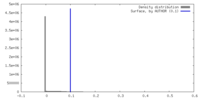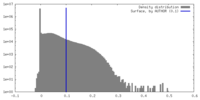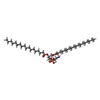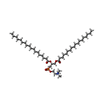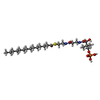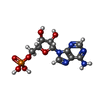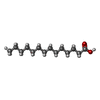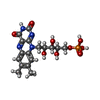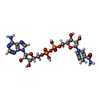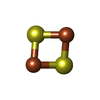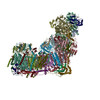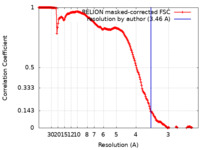+ Open data
Open data
- Basic information
Basic information
| Entry |  | |||||||||
|---|---|---|---|---|---|---|---|---|---|---|
| Title | Complex I from Ovis aries at pH7.4, Closed state | |||||||||
 Map data Map data | Composite map | |||||||||
 Sample Sample |
| |||||||||
| Function / homology |  Function and homology information Function and homology informationmyoblast migration involved in skeletal muscle regeneration / negative regulation of skeletal muscle satellite cell proliferation / : / : / oxidoreductase activity, acting on NAD(P)H / NADH dehydrogenase activity / positive regulation of macrophage chemotaxis / ubiquinone binding / acyl binding / electron transport coupled proton transport ...myoblast migration involved in skeletal muscle regeneration / negative regulation of skeletal muscle satellite cell proliferation / : / : / oxidoreductase activity, acting on NAD(P)H / NADH dehydrogenase activity / positive regulation of macrophage chemotaxis / ubiquinone binding / acyl binding / electron transport coupled proton transport / acyl carrier activity / apoptotic mitochondrial changes / NADH:ubiquinone reductase (H+-translocating) / mitochondrial ATP synthesis coupled electron transport / mitochondrial respiratory chain complex I assembly / mitochondrial electron transport, NADH to ubiquinone / respiratory chain complex I / membrane => GO:0016020 / NADH dehydrogenase (ubiquinone) activity / positive regulation of myoblast differentiation / quinone binding / ATP metabolic process / ATP synthesis coupled electron transport / positive regulation of lamellipodium assembly / reactive oxygen species metabolic process / regulation of mitochondrial membrane potential / transcription coregulator activity / respiratory electron transport chain / electron transport chain / circadian rhythm / mitochondrial membrane / mitochondrial intermembrane space / 2 iron, 2 sulfur cluster binding / NAD binding / FMN binding / 4 iron, 4 sulfur cluster binding / response to oxidative stress / mitochondrial inner membrane / mitochondrial matrix / chromatin / protein-containing complex binding / positive regulation of transcription by RNA polymerase II / mitochondrion / metal ion binding / nucleus / membrane Similarity search - Function | |||||||||
| Biological species |   | |||||||||
| Method | single particle reconstruction / cryo EM / Resolution: 3.46 Å | |||||||||
 Authors Authors | Sazanov L / Petrova O | |||||||||
| Funding support | European Union, 1 items
| |||||||||
 Citation Citation |  Journal: Nature / Year: 2022 Journal: Nature / Year: 2022Title: A universal coupling mechanism of respiratory complex I. Authors: Vladyslav Kravchuk / Olga Petrova / Domen Kampjut / Anna Wojciechowska-Bason / Zara Breese / Leonid Sazanov /    Abstract: Complex I is the first enzyme in the respiratory chain, which is responsible for energy production in mitochondria and bacteria. Complex I couples the transfer of two electrons from NADH to quinone ...Complex I is the first enzyme in the respiratory chain, which is responsible for energy production in mitochondria and bacteria. Complex I couples the transfer of two electrons from NADH to quinone and the translocation of four protons across the membrane, but the coupling mechanism remains contentious. Here we present cryo-electron microscopy structures of Escherichia coli complex I (EcCI) in different redox states, including catalytic turnover. EcCI exists mostly in the open state, in which the quinone cavity is exposed to the cytosol, allowing access for water molecules, which enable quinone movements. Unlike the mammalian paralogues, EcCI can convert to the closed state only during turnover, showing that closed and open states are genuine turnover intermediates. The open-to-closed transition results in the tightly engulfed quinone cavity being connected to the central axis of the membrane arm, a source of substrate protons. Consistently, the proportion of the closed state increases with increasing pH. We propose a detailed but straightforward and robust mechanism comprising a 'domino effect' series of proton transfers and electrostatic interactions: the forward wave ('dominoes stacking') primes the pump, and the reverse wave ('dominoes falling') results in the ejection of all pumped protons from the distal subunit NuoL. This mechanism explains why protons exit exclusively from the NuoL subunit and is supported by our mutagenesis data. We contend that this is a universal coupling mechanism of complex I and related enzymes. | |||||||||
| History |
|
- Structure visualization
Structure visualization
| Supplemental images |
|---|
- Downloads & links
Downloads & links
-EMDB archive
| Map data |  emd_14648.map.gz emd_14648.map.gz | 3.9 MB |  EMDB map data format EMDB map data format | |
|---|---|---|---|---|
| Header (meta data) |  emd-14648-v30.xml emd-14648-v30.xml emd-14648.xml emd-14648.xml | 57.5 KB 57.5 KB | Display Display |  EMDB header EMDB header |
| FSC (resolution estimation) |  emd_14648_fsc.xml emd_14648_fsc.xml | 17.8 KB | Display |  FSC data file FSC data file |
| Images |  emd_14648.png emd_14648.png | 54.8 KB | ||
| Archive directory |  http://ftp.pdbj.org/pub/emdb/structures/EMD-14648 http://ftp.pdbj.org/pub/emdb/structures/EMD-14648 ftp://ftp.pdbj.org/pub/emdb/structures/EMD-14648 ftp://ftp.pdbj.org/pub/emdb/structures/EMD-14648 | HTTPS FTP |
-Related structure data
| Related structure data | 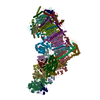 7zdhMC  7p61C  7p62C  7p63C  7p64C  7p69C  7p7cC  7p7eC  7p7jC  7p7kC  7p7lC  7p7mC  7z7rC  7z7sC  7z7tC  7z7vC  7z80C  7z83C  7z84C  7zc5C  7zciC 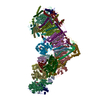 7zd6C 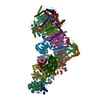 7zdjC 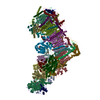 7zdmC 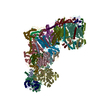 7zdpC 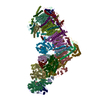 7zebC C: citing same article ( M: atomic model generated by this map |
|---|---|
| Similar structure data | Similarity search - Function & homology  F&H Search F&H Search |
- Links
Links
| EMDB pages |  EMDB (EBI/PDBe) / EMDB (EBI/PDBe) /  EMDataResource EMDataResource |
|---|---|
| Related items in Molecule of the Month |
- Map
Map
| File |  Download / File: emd_14648.map.gz / Format: CCP4 / Size: 20.4 MB / Type: IMAGE STORED AS FLOATING POINT NUMBER (4 BYTES) Download / File: emd_14648.map.gz / Format: CCP4 / Size: 20.4 MB / Type: IMAGE STORED AS FLOATING POINT NUMBER (4 BYTES) | ||||||||||||||||||||||||||||||||||||
|---|---|---|---|---|---|---|---|---|---|---|---|---|---|---|---|---|---|---|---|---|---|---|---|---|---|---|---|---|---|---|---|---|---|---|---|---|---|
| Annotation | Composite map | ||||||||||||||||||||||||||||||||||||
| Projections & slices | Image control
Images are generated by Spider. generated in cubic-lattice coordinate | ||||||||||||||||||||||||||||||||||||
| Voxel size | X=Y=Z: 1.22 Å | ||||||||||||||||||||||||||||||||||||
| Density |
| ||||||||||||||||||||||||||||||||||||
| Symmetry | Space group: 1 | ||||||||||||||||||||||||||||||||||||
| Details | EMDB XML:
|
-Supplemental data
- Sample components
Sample components
+Entire : Complex I from Ovis aries at pH7.4, Closed state
+Supramolecule #1: Complex I from Ovis aries at pH7.4, Closed state
+Macromolecule #1: NADH-ubiquinone oxidoreductase chain 3
+Macromolecule #2: NADH-ubiquinone oxidoreductase chain 1
+Macromolecule #3: NADH-ubiquinone oxidoreductase chain 6
+Macromolecule #4: NADH-ubiquinone oxidoreductase chain 4L
+Macromolecule #5: NADH-ubiquinone oxidoreductase chain 5
+Macromolecule #6: NADH-ubiquinone oxidoreductase chain 4
+Macromolecule #7: NADH-ubiquinone oxidoreductase chain 2
+Macromolecule #8: NADH dehydrogenase [ubiquinone] 1 alpha subcomplex subunit 11
+Macromolecule #9: NADH dehydrogenase [ubiquinone] 1 beta subcomplex subunit 5, mito...
+Macromolecule #10: Acyl carrier protein
+Macromolecule #11: NADH dehydrogenase [ubiquinone] 1 alpha subcomplex subunit 8
+Macromolecule #12: NADH dehydrogenase [ubiquinone] 1 beta subcomplex subunit 10
+Macromolecule #13: NADH dehydrogenase [ubiquinone] 1 alpha subcomplex subunit 10, mi...
+Macromolecule #14: NADH dehydrogenase [ubiquinone] iron-sulfur protein 5
+Macromolecule #15: NADH dehydrogenase [ubiquinone] 1 alpha subcomplex subunit 3
+Macromolecule #16: NADH dehydrogenase [ubiquinone] 1 beta subcomplex subunit 3
+Macromolecule #17: NADH dehydrogenase [ubiquinone] 1 subunit C2
+Macromolecule #18: NADH:ubiquinone oxidoreductase subunit B4
+Macromolecule #19: NADH dehydrogenase [ubiquinone] 1 alpha subcomplex subunit 13
+Macromolecule #20: Mitochondrial complex I, B17 subunit
+Macromolecule #21: NADH dehydrogenase [ubiquinone] 1 beta subcomplex subunit 7
+Macromolecule #22: NADH dehydrogenase [ubiquinone] 1 beta subcomplex subunit 9
+Macromolecule #23: NADH dehydrogenase [ubiquinone] 1 beta subcomplex subunit 2, mito...
+Macromolecule #24: NADH dehydrogenase [ubiquinone] 1 beta subcomplex subunit 8, mito...
+Macromolecule #25: NADH dehydrogenase [ubiquinone] 1 beta subcomplex subunit 11, mit...
+Macromolecule #26: NADH dehydrogenase [ubiquinone] 1 subunit C1, mitochondrial
+Macromolecule #27: NADH dehydrogenase [ubiquinone] 1 beta subcomplex subunit 1
+Macromolecule #28: Complex I-MWFE
+Macromolecule #29: NADH dehydrogenase [ubiquinone] flavoprotein 1, mitochondrial
+Macromolecule #30: NADH dehydrogenase [ubiquinone] flavoprotein 2, mitochondrial
+Macromolecule #31: NADH-ubiquinone oxidoreductase 75 kDa subunit, mitochondrial
+Macromolecule #32: NADH dehydrogenase [ubiquinone] iron-sulfur protein 2, mitochondrial
+Macromolecule #33: NADH dehydrogenase [ubiquinone] iron-sulfur protein 3, mitochondrial
+Macromolecule #34: NADH dehydrogenase [ubiquinone] iron-sulfur protein 7, mitochondrial
+Macromolecule #35: Complex I-23kD
+Macromolecule #36: NADH dehydrogenase [ubiquinone] flavoprotein 3, mitochondrial
+Macromolecule #37: NADH dehydrogenase [ubiquinone] iron-sulfur protein 6, mitochondrial
+Macromolecule #38: NADH dehydrogenase [ubiquinone] iron-sulfur protein 4, mitochondrial
+Macromolecule #39: NADH:ubiquinone oxidoreductase subunit A9
+Macromolecule #40: NADH dehydrogenase [ubiquinone] 1 alpha subcomplex subunit 2
+Macromolecule #41: Mitochondrial complex I, B13 subunit
+Macromolecule #42: NADH:ubiquinone oxidoreductase subunit A6
+Macromolecule #43: Mitochondrial complex I, B14.5a subunit
+Macromolecule #44: NADH dehydrogenase [ubiquinone] 1 alpha subcomplex subunit 12
+Macromolecule #45: 1,2-Distearoyl-sn-glycerophosphoethanolamine
+Macromolecule #46: 1,2-DIACYL-SN-GLYCERO-3-PHOSPHOCHOLINE
+Macromolecule #47: S-[2-({N-[(2S)-2-hydroxy-3,3-dimethyl-4-(phosphonooxy)butanoyl]-b...
+Macromolecule #48: ADENOSINE MONOPHOSPHATE
+Macromolecule #49: MYRISTIC ACID
+Macromolecule #50: IRON/SULFUR CLUSTER
+Macromolecule #51: FLAVIN MONONUCLEOTIDE
+Macromolecule #52: 1,4-DIHYDRONICOTINAMIDE ADENINE DINUCLEOTIDE
+Macromolecule #53: FE2/S2 (INORGANIC) CLUSTER
+Macromolecule #54: POTASSIUM ION
+Macromolecule #55: ZINC ION
+Macromolecule #56: NADPH DIHYDRO-NICOTINAMIDE-ADENINE-DINUCLEOTIDE PHOSPHATE
-Experimental details
-Structure determination
| Method | cryo EM |
|---|---|
 Processing Processing | single particle reconstruction |
| Aggregation state | particle |
- Sample preparation
Sample preparation
| Concentration | 3 mg/mL |
|---|---|
| Buffer | pH: 7.4 |
| Grid | Model: Quantifoil / Material: COPPER |
| Vitrification | Cryogen name: ETHANE / Chamber humidity: 100 % / Chamber temperature: 277 K / Instrument: FEI VITROBOT MARK IV |
- Electron microscopy
Electron microscopy
| Microscope | TFS GLACIOS |
|---|---|
| Image recording | Film or detector model: FEI FALCON III (4k x 4k) / Average exposure time: 3.3 sec. / Average electron dose: 90.0 e/Å2 |
| Electron beam | Acceleration voltage: 200 kV / Electron source:  FIELD EMISSION GUN FIELD EMISSION GUN |
| Electron optics | Illumination mode: FLOOD BEAM / Imaging mode: BRIGHT FIELD / Nominal defocus max: 2.0 µm / Nominal defocus min: 1.0 µm / Nominal magnification: 120000 |
| Sample stage | Cooling holder cryogen: NITROGEN |
 Movie
Movie Controller
Controller











































































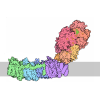

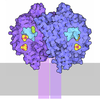


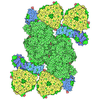


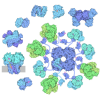

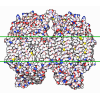

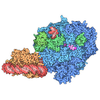
 X (Sec.)
X (Sec.) Y (Row.)
Y (Row.) Z (Col.)
Z (Col.)


















